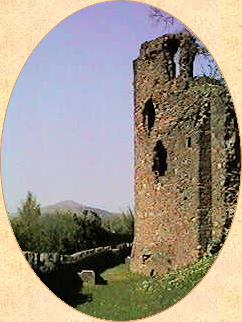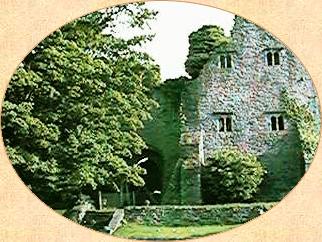
Blood
Feuds

William
de Braose junior celebrated his new lordships in 1175 with a
Christmas feast at Abergavenny
castle. The princes
and chieftains of Gwent were invited, including Seisyll ap Dyfnwal,
lord of Upper Gwent and his son Gruffydd. Seisyll was the murderer
of William's uncle Henry.
Those gathered in the great
hall had recently met king Henry at Gloucester to pledge peace
and fealty. The Welsh laid down their weapons for the feast but
the drunken merry making came to a dramatic halt when William
challenged them never again to bear arms in his domains, according
to the king's order. Seisyll indignantly refused. William's men
took this as the signal to slaughter all his Welsh guests.
The murder of William's
uncle Henry had benefited the de Braoses well but it was savagely
avenged. William pursued Seisyll's wife Gwladus and cut down
the son she was protecting in her arms, seven year old Cadwaladr.
Seisyll's lands were ravaged.
Seven
years later, Seisyll's surviving sons in turn avenged the massacre
by burning most of Abergavenny castle to the ground. The keep
held out, however, William retained his stronghold and an imposing
new castle was built. This fourth Lord of Bramber married a formidable
woman, Maud de Saint Valery, sometimes called Matilda. She supported
her husband's military ambitions and he put her in charge of
Hay castle and surrounding
lands. Welsh folklore portrays her as a giantess and a witch.
In 1198 Gwenwynwyn, prince
of Powys, threatened the entire Welsh middle marches after the
death of Lord Rhys. William de Braose hurried to defend Brecon
while a terrified and unprepared force marched to intercept Gwenwynwyn
as he swept towards Hay.

Maud de Saint Valery appeared
before the English army disguised as a nun. She was accompanied
by a Welsh hermit from Llowes who assured the men that they should
go into battle without fear. "And they believed him, as
being a holy man, they did so, and in one day slew of the Welsh
three thousand." (8.1)
William de Braose instigated
another furious blood feud in his reprisals against Gwenwynwyn's
campaign. He seized the lord of Llangorse, Trehearn Fychan, and
bound him to the tail of a horse. To the shame and fury of the
Welsh, he dragged the man through the town of Brecon then had
him beheaded. The body was hung up by the feet to rot on a common
gallows.
Gwenwynwyn vowed revenge
and returned to besiege Painscastle, known as "Matilda's
castle" in Elfael. Maud held off the massive Welsh attack
for three weeks until Norman reinforcements arrived. Welsh bards
wrote mournfully of the three thousand seven hundred Welsh men
who were slaughtered there.
Bad blood between the de
Braoses and the Welsh continued for generations.

back
to text

back
to text
William de Braose junior celebrated his new lordships in 1175 with a Christmas feast at Abergavenny castle. The princes and chieftains of Gwent were invited, including Seisyll ap Dyfnwal, lord of Upper Gwent and his son Gruffydd. Seisyll was the murderer of William's uncle Henry. Those gathered in the great hall had recently met king Henry at Gloucester to pledge peace and fealty. The Welsh laid down their weapons for the feast but the drunken merry making came to a dramatic halt when William challenged them never again to bear arms in his domains, according to the king's order. Seisyll indignantly refused. William's men took this as the signal to slaughter all his Welsh guests. The murder of William's uncle Henry had benefited the de Braoses well but it was savagely avenged. William pursued Seisyll's wife Gwladus and cut down the son she was protecting in her arms, seven year old Cadwaladr. Seisyll's lands were ravaged. Seven years later, Seisyll's surviving sons in turn avenged the massacre by burning most of Abergavenny castle to the ground. The keep held out, however, William retained his stronghold and an imposing new castle was built. This fourth Lord of Bramber married a formidable woman, Maud de Saint Valery, sometimes called Matilda. She supported her husband's military ambitions and he put her in charge of Hay castle and surrounding lands. Welsh folklore portrays her as a giantess and a witch. In 1198 Gwenwynwyn, prince
of Powys, threatened the entire Welsh middle marches after the
death of Lord Rhys. William de Braose hurried to defend Brecon
while a terrified and unprepared force marched to intercept Gwenwynwyn
as he swept towards Hay.  Maud de Saint Valery appeared before the English army disguised as a nun. She was accompanied by a Welsh hermit from Llowes who assured the men that they should go into battle without fear. "And they believed him, as being a holy man, they did so, and in one day slew of the Welsh three thousand." (8.1) William de Braose instigated another furious blood feud in his reprisals against Gwenwynwyn's campaign. He seized the lord of Llangorse, Trehearn Fychan, and bound him to the tail of a horse. To the shame and fury of the Welsh, he dragged the man through the town of Brecon then had him beheaded. The body was hung up by the feet to rot on a common gallows. Gwenwynwyn vowed revenge and returned to besiege Painscastle, known as "Matilda's castle" in Elfael. Maud held off the massive Welsh attack for three weeks until Norman reinforcements arrived. Welsh bards wrote mournfully of the three thousand seven hundred Welsh men who were slaughtered there. Bad blood between the de
Braoses and the Welsh continued for generations.
|
||||